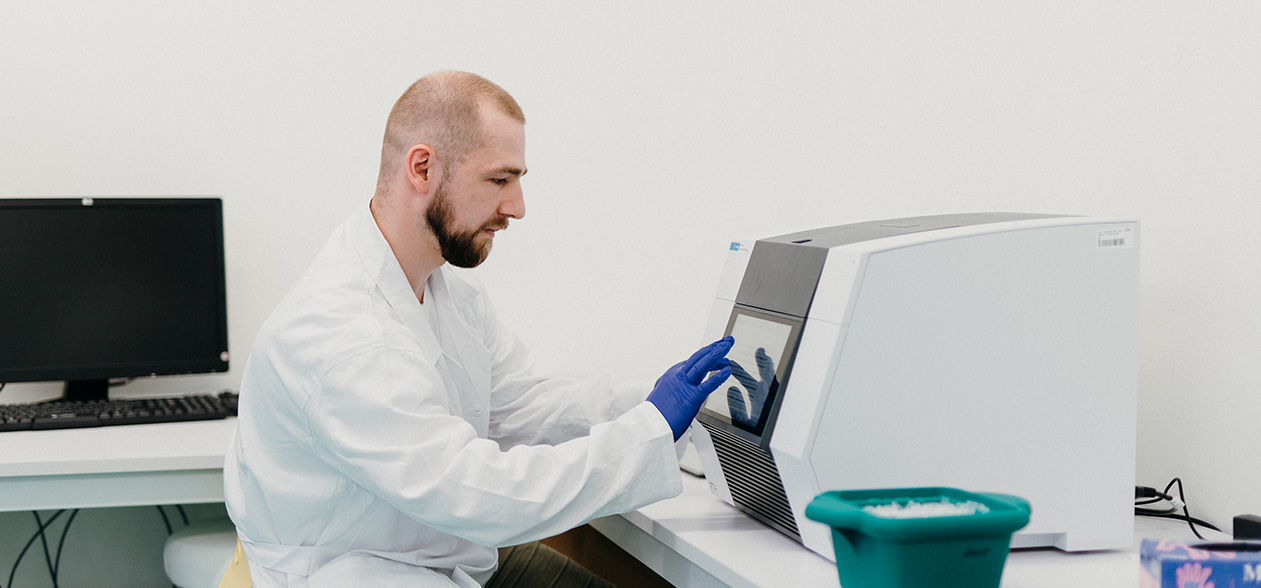
Italian universities do not have better technical facilities. In Slovakia, however, I lack their self-confidence, says biotechnologist Milan Karas
Instead of chemical sprays, he develops biological "vaccines" for plants. The Slovak scientist and graduate of the Faculty of Natural Sciences at UCM is working at the prestigious University of Bologna and believes that thanks to his research, new biotechnologies can change agriculture across Europe.
I read on the website of the University of Bologna, where you are currently based, that you specialise in sustainable disease management strategies in agriculture. If I understand correctly, this is, in simple terms, plant protection without the use of chemical pesticides?
Exactly. It is about trying to develop biological alternatives to conventional chemical pesticides. If I were to explain it simply, it is a bit like vaccines for humans, only in this case we are developing them for plants.
The way it works in practice is that we first need to know very well the disease-causing agent itself. In my case, it is mainly fungal pathogens, that is to say, various moulds and related organisms. From their genome, we try to identify unique genes, i.e. those that are crucial for the survival or spread of the unwanted pathogen. The aim is to block these genes, but without using conventional chemical sprays. To do this, we use RNAi, or RNA interference, which is a natural part of all living things. With its help, we can very precisely intervene in the life cycle of the pathogen and thus protect the plants.
Try to describe this process to me in more detail.
In classical biology, a simple principle applies. All information about living organisms is stored in DNA. When we want to build a body or parts of a body, the DNA is first transcribed into RNA and from there into proteins, which build not only human or animal bodies, but also plants or fungi.
The principle of my work is to stop this process at the second step, the RNA stage, before the proteins are formed. We create an RNAi molecule, which is, so to speak, the "opposite" of the RNA that arises from DNA. When these two RNA molecules meet, they come together and the process of protein formation stops. If we set this up correctly, my opposite RNA will only "attack" the specific unwanted pathogen and will not affect the growth of the plant itself. The goal is to protect it without using chemicals and without interfering with its healthy development.

Is it an interference with the genome of the plant itself?
No, it is not genetic modification. We are not changing the DNA in any way, which is why it is a very interesting method at the moment. If it can be approved within the European Union, we can use it as a substitute for pesticides.
So, if it is not genetic modification, how can we imagine this technology in practice?
It basically works on the same principle as chemical pesticides. The result of my work can be a classical spray, with which we apply the aforementioned interfering, i.e. opposite, RNA to the plant, which works successfully on it for a certain period of time. Unlike pesticides, however, it is not harmful in any way.
The big problem is that RNAi as a molecule is very unstable and breaks down easily. So one of my goals is to find a way to protect this RNAi long enough to be effectively usable on the plant for more than a few days. In practice, this will only work if farmers do not have to go out into the field a million times and repeat the spraying all the time.
What crop pathogens are you most concerned with?
As I am currently based in Bologna, I am working on local crops and the fungal pathogens that cause the most damage to these crops. In particular, pears, strawberries, apples and vines.
What you have just described to me sounds a little like the future of agriculture cut out of a science fiction film. Are we talking about a method that is already widespread in some form today, or is its implementation in agricultural practice a matter of years or decades?
Although it is a relatively new technology, its application in practice is no longer a major problem. The biggest challenge is to design the RNAi molecule very precisely for each individual pathogen so that it works effectively. You have to go through thousands of tests before you find the right one. It's similar to drug development for humans. It takes about five years from the start of research to the final product.
That's why we are currently focusing on the most harmful pathogens. Once we have a solution for them, I expect that other research teams will also focus on less dangerous species. At present, for example, it has already been successfully implemented against potato-eating insects.

This reminded me of the legendary "mandelines" that the socialist regime used to scare our parents with.
Those are exactly the ones I have in mind (ed. note: the technical name is the potato caterpillar). There is already a product on the market that works against them and it is widely sold. However, we are currently trying to extend this technology to other pathogens.
Let's imagine you succeed. How would its widespread adoption in global practice change the agricultural industry?
Let me give an example of the two fungal pathogens of grapevine that I am most involved in researching. Farmers currently have to use very large quantities of really toxic fungicides against them. Normally twelve or thirteen times a year.
If we could replace these sprays with our technology, we would significantly reduce the amount of heavy metals and chemicals that enter the environment and negatively affect the health of people, animals, beneficial insects and bacteria that are beneficial to plants.
So it would be a really big breakthrough.
I very much hope so, as the European Union itself is trying to significantly reduce the use of chemical pesticides, fungicides and other chemicals that are applied in agriculture. That is also why many farmers and cultivation companies are investing heavily in these technologies in the hope that they will be used in Europe as a replacement for conventional chemicals.
Does this also apply to Slovak agriculture? Are there people here who know what you are doing and are prepared to apply it?
I'm honestly not sure about that. I assume that they are not investing heavily in this technology. However, we recently had our vice-dean from UCM here and, together with my supervisor, we talked a lot about the cooperation between the University of Bologna on this type of research. Therefore, I believe that, thanks to UCM, this technology will eventually reach Slovakia.
Correct me if I am wrong, but I assume that you are working at the University of Bologna precisely because it is a leading institution in Europe in this area of research.
The professor here, who is also the head of my research, is one of the most respected experts in this field. So, yes, as a university we are very much involved in this area. However, there are a number of similar research groups across universities throughout Europe, each working on different pathogens that affect their particular regions and crops more or less independently.
In addition, there are also two large companies working on these technologies. One of them is in the US and is called Greenlight, the other is in South Korea and is called Genolution. Both are concentrating on the production of these molecules for commercial purposes.

My guess is that if your research is successful on various pathogens in the coming years, these two companies will be among the first to reach for your results.
We are already working with Greenlight. We are developing the technology for them, designing new RNAi, and in return they are helping us with production, as the price is not very low yet. When big companies come into development, they can reduce the cost of production much more compared to what we can do in the lab.
When we arranged our online interview a while back, we had to reschedule it because one of your field experiments came up unexpectedly. You wrote to me that they are extremely dependent on the current weather. What part of your research do you do in the field?
This particular experiment was linked to other research we are doing - what we call biocontrol. For plants, there are not only harmful bacteria or fungi, but also beneficial ones that colonise the plant but do not produce any negative symptoms. On the contrary, by colonising the plant, they prevent unwanted pathogens from attacking it.
Biocontrol is carried out when climatic conditions are most suitable for the development of harmful fungi and other pathogens that are dependent on rainfall and specific times of the year. At that time, we apply beneficial organisms to the plants in order to protect them. Well, you came with the request for an interview at this specific time (laughs).
As we outlined in the introduction, you have a postdoctoral position at the University of Bologna, which is considered to be the oldest in the world. How did you get here from your PhD in biotechnology at UCM?
During my PhD studies, I benefited a lot from an Erasmus stay at the Università Politecnica delle Marche in Ancona, Italy. I studied there under the guidance of Professor Bruno Mezzetti, who is one of the extremely successful scientists with a great reputation throughout Europe.
When the people of Bologna were looking for suitable candidates for my current position, they turned to Bruno to recommend someone. He approached me to see if I would like to take part in the selection process. I was interested in the topic and also in the prestige of the university itself, so I applied and managed to succeed.
Compared to Slovakia, what surprised you the most when you started working at an Italian university - be it in the field of science, communication or academic infrastructure?
I dare to say that the Italians have no better university facilities than we have in Slovakia. I don't see better laboratories or technical facilities here. I see a big difference in self-esteem. They have absolutely no problem here coming up with new ideas and trying anything that seems interesting or meaningful to them. I really miss that kind of self-confidence in Slovak universities.
There is also strong cooperation with companies that actively seek knowledge and solutions from universities. I do not see this intermediate link in Slovakia. Farmers often do not want to invest in cooperation with universities. Either they consider it unnecessary or a luxury that will bring them nothing. In Italy, on the contrary, it brings them a great deal.
We work with farmers and with various companies, giving them a head start that makes agriculture here very self-sufficient. Even though it is partly subsidised by the European Union, it is still able to earn enough money to thrive.

